
Shoulder-boards
A shoulder-board refers to the piece of cloth worn on the shoulder of both blouse and greatcoat by Russian soldiers which carried unit and rank markings. They had been a key feature of the Imperial Russian Army, and the new White armies carried over the regulations, in direct contrast to the revolutionary armies (Red Army, KOMUCH and early Czechs) who did not wear anything on the shoulders at all.
Shoulder-board is used for the Russian word Погон, plural Погоны (transliterated as pogony). Shoulder-strap is another translation often seen. We prefer either to the term epaulettes, because they do not in general resemble the standard European epaulettes (in fact the Russians also used the frilly edged type in some dress uniforms).
Basics of the Imperial System
Units were distinguished by a system of base colour, piping colour, metal colour, monograms and branch of service symbols. As well as this, each man's rank was indicated by a system of stripes and stars. The result was a splendid mix of colour and symbol, as can be seen from these Imperial ones:
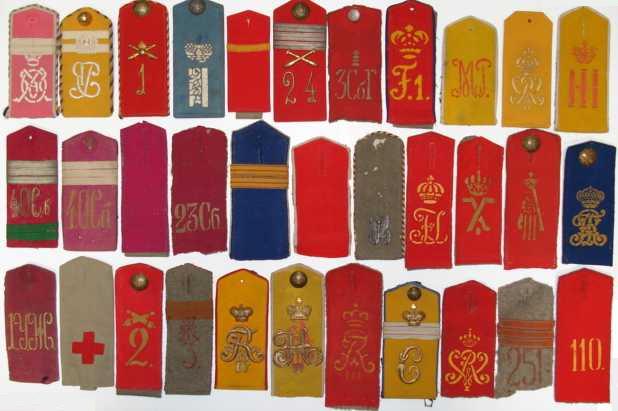
There was an official size, but clearly from the above picture, we can largely ignore it. What matters is that they were very large, extending from the base of the neck to the point of the shoulder.
For rankers, cadets and NCOs the shape was a basic rectangle with the neck edge cut to form a wide point. For officers the shape was a rectangle with only the corners by the button hole cut away, leaving the shape seen in the second from right in the top row.
Originally stiff and detachable, by the end of WWI most front-line versions were soft, and many were sewn directly onto the blouse or coat. (Obviously the attaching button was not required if they were sewn on, which is why some do not have holes.)
For rankers one side was coloured for dress and the reverse was khaki for field use.
Officers were meant to wear coloured shoulder-boards at all times, though WWI field versions were often considerably less ornate and colourful, sometimes little more than light cloth with markings sewn or pencilled on.
Some shoulder-boards were edged with colour or braid, either as unit markings or to mark a particular individual distinction. The piping, in either case, did not run along the bottom edge.
Rank Markings
For NCOs rank was marked by horizontal stripes. Originally these had been in yellow or white (orange for guard) but in WWI were changed to red. A Sergeant-Major was marked by a wide stripe in the regimental metal or red (sources differ).
Officers were marked by a system of vertical stripes and stars, in the regimental metal. Oddly, the most senior rank had no stars.
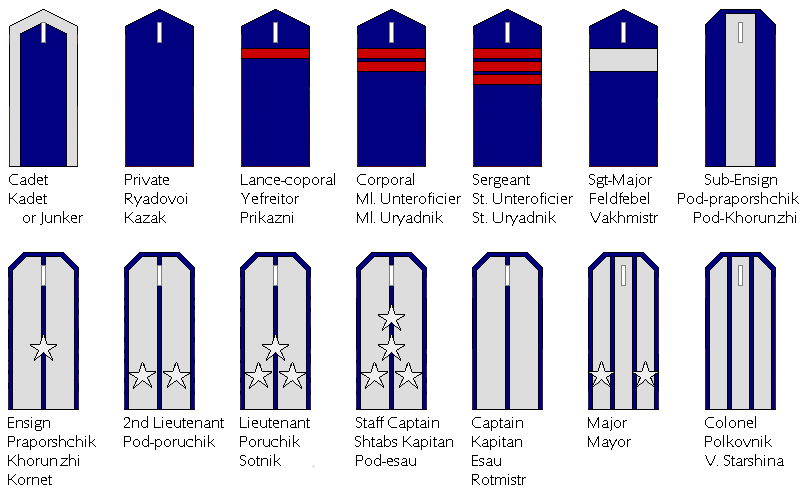
This diagram gives the basic system with the most common markings. In reality the stars were usually quite small and often had to fit around the cipher. The ranks are given above in their transliterated form with Cossack and/or cavalry alternatives below. A Lieutenant-Colonel (Pod-polkovnik or Voiskovoi Starshina) had three stars, and there was a grade of Sergeant-Major with a downwards as well as the cross stripe. Majors and Colonels often had a much wider central stripe than the side ones.
Generals had a zig-zag of braid with the same system of stars marking the various grades.
There were also some special markings.

In addition to their other markings, volunteers were marked with white, orange and black twisted braid if they were educated sufficiently to be officer material, and in white, red and blue if rankers. With the abdication of the Tsar that presumably changed to white, blue and red for all.
Hussars had special additional zig-zags on their metal.
Mounted and artillery scouts had a thin vertical stripe in addition to other markings, though a horizontal stripe at the base is also sometimes cited.
Some ranks were peculiar to the artillery, and had special markings as a result.
During WWI officer shoulder-boards were made with the metal stripes in cloth, khaki for the greatcoat and greener moleskin for the blouse. Often photographs show the metal versions, and it is clear that in the Civil War the full versions of shoulder-boards made a large comeback.
Unit Ciphers and Monograms

Most units had a monogram or cipher, which distinguished it from other units of the same base colour. Normally this was the unit's number and some abbreviated form of the name.
Prior to WWI some letters were in Italic form. As Cyrillic Italics often have very different shapes from the normal form, this can cause confusion when looking at old monograms.
However in 1911 the order to the right was given, showing the official forms of each letter that were to be used.
Arabic numerals were used, except Corps level used Roman ones.
Regulations seems to have been that ciphers that involved abbreviating the name had dots after the letters. In practice it seems few men bothered to put the dots on.
There were also a large number of units who had been given a cipher in honour of some Royal patron, sometimes foreign. These monograms took a variety of shapes, often very intricate. Presumably those with monograms of German or Austrian royalty removed them in 1914.
Branch of Service Badges
Specialist troops added a badge of service above the cipher or monogram, metal for officers and stencilled for men.
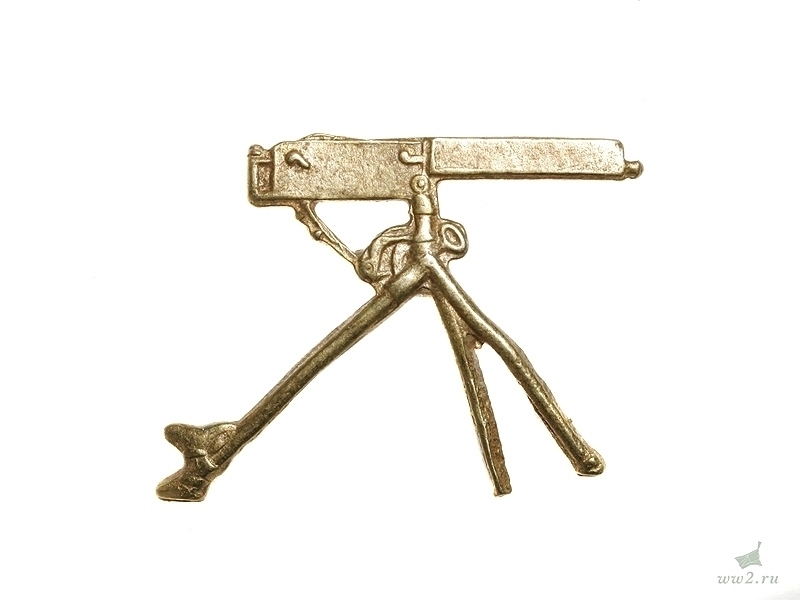 |
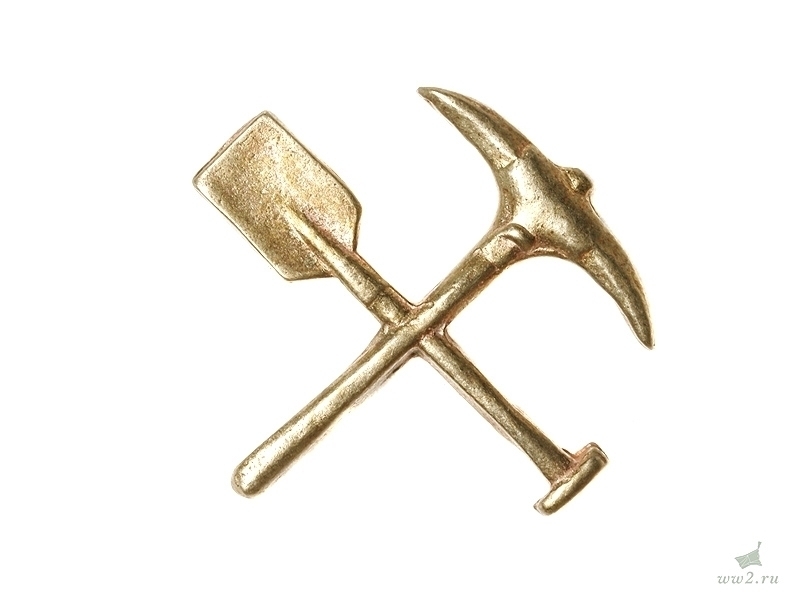 |
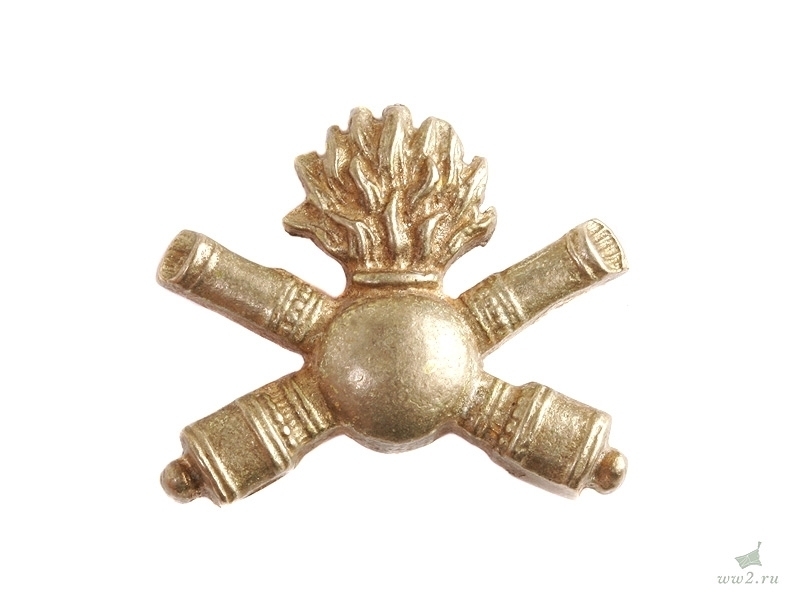 |
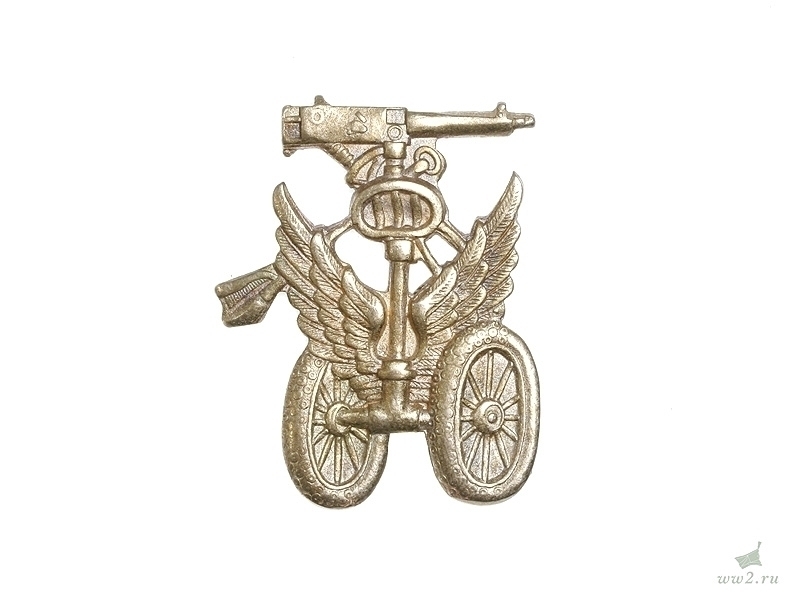 |
Machine-gunners had an MG, sappers had crossed tools, artillery had crossed cannons, grenadiers had flaming grenades (on top of cannons or tools if artillery or sappers) and armoured cars had an MG on winged wheels.
Colours
All the men in a regiment had the same base colour and markings on their shoulder-boards. The colour might depend on the type of unit (Grenadiers were yellow, Rifles were raspberry), or come from the Cossack Host (Kuban were red, Terek were blue) or might be regimental (Guards and Cavalry). Any decent uniform book will give the colours for the most common unit types.
The base metal colour of the rank markings and buttons were either gold or silver. Again they varied according to unit type, Host or just by regiment for Guards. Most uniform sources will list the variety.
Officers had their unit markings embroidered on in metallic thread or had small metal letters sewn on. Those of mounted units had their distinguishing marks in the opposite metal, that is if the regiment had gold buttons then the monograms etc were in silver and vice versa. Officers of other branches, and any unit with the Tsar, Tsarina or Tsarevich as the Colonel-in-Chief, had markings in the same metal.
For the coloured shoulder-boards, other ranks had the markings stencilled on in yellow paint, or scarlet if the base colour was white, yellow or dark-blue.
On the khaki side, stencilling was:
- yellow = infantry (not guards)
- crimson / raspberry = rifle regiments and their attached artillery
- dark blue = Cossacks
- light blue = cavalry (but not Cossacks or guards) and horse and horse-mountain artillery
- scarlet = artillery (but not rifle, Cossack, fortress or horse artillery)
- orange = corps staff and fortress artillery
- brown = engineers, telegraph troops and air units
- green = railway troops
- guards had regimental colours (although most were plain in any event)
Collar, Sleeve and Arm markings
Greatcoats for all men, except those wearing Caucasian dress, had a tab of coloured cloth on both collars. There was a button in regimental metal for NCOs and officers.
Troops with specialist positions inside normal infantry or cavalry units wore the same uniform as the rest of the unit including shoulder-boards, and instead marked their speciality elsewhere.
Telephonists wore crossed thunderbolts on their left arm (see figure D1 in the Whites Osprey). Grenadier platoons wore a flaming grenade (see figure C4 in the WWI Osprey). Pioneers crossed tools.
Infantry scouts wore wide green braid on their cuffs (whereas cavalry and artillery scouts marked themselves with a vertical stripe on the shoulder-boards).
Machine-gunners wore wide red braid on their cuffs in all services (see figure C3 in the WWI Osprey, who has MG lace on his greatcoat, plus the badge on the shoulder-board).
Sources
The Handbook of the Russian Army goes into the detail of all the colours, ciphers, monograms and badges, including rear element and specialised units not listed above. In some cases the information is out of date due to developments during the war, but we have noted those for units in the uniform section when we know of the changes.
The Osprey The Russian Army 1914-18 gives the basic information, but it does not list all the monograms, ciphers etc.
There is an interesting discussion of the developments of shoulder-boards at www.army.armor.kiev.ua.
Changes for the Civil War
As we see above, the system in Imperial times was quite complicated and it appears many men did not follow regulations even during the Great War. By the Civil War it was rare to see shoulder-boards on greatcoats, and often even blouses are missing them.
Shortages during the period meant that many shoulder-boards were quite rudimentary, sometimes simple sewn on cloth with markings pencilled on. However, mostly they were worn, and it was frequently with the coloured side showing.
It seems likely that any monograms for royalty were discarded in 1917, though we cannot be sure, and overtly monarchist officers may have kept them.
It seems likely that tachanka crews should have worn the red cuff braid and MG badge on their shoulder-boards of machine-gun units, since they were effectively just cavalry machine-gunners.